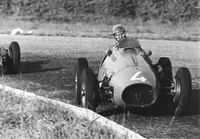Famous GP Ferrari for Phillip Island Classic
MELBOURNE – Feb 27, 2012: The most successful Grand Prix car of the modern era – the Ferrari Tipo 500 that brought the Maranello manufacturer its first World Championship 60 years ago – is being flown to Melbourne for a starring role at the 23rd annual Phillip Island Classic Festival of Motorsport from March 9-11.
Driven by Italian ace Alberto Ascari, the Tipo 500 Chassis No 5 won the 1952 Belgian Grand Prix and went on to win a further five of the seven races counting towards the 1952 World Championship.
The only race that Ascari and Chassis No 5 failed to win that year was while he was absent in the Indianapolis 500 driving the 4.5-litre Ferrari.
Ascari won nine straight races in Tipo 500 No 5, a world championship record for an individual Formula 1 chassis that still stands today.
The Tipo 500 also won all but one of the 11 races in which it was entered, making it statistically the second most successful car in the history of the FIA World Championship after the McLaren MP4/4, which failed to win only one of its 16 races.
However Ferrari Tipo 500 Chassis No. 5 had an equally famous after-life Down Under in the hands of two notable Australian drivers.
Australia’s first Formula 1 driver, ex-WWII Spitfire Squadron leader Tony Gaze, purchased the Ferrari following the 1953 season and replaced its original 2.0-litre in-line four cylinder twin cam engine with a later 750 Monza 3.0-litre engine acquired from the Ferrari factory.
He campaigned the car extensively in South Africa and New Zealand, scoring a number of victories and podium places before selling it to Australia’s Lex Davison in 1956.
Davison went on to write the Ferrari into some of the most glorious chapters of Australian motorsport, winning six major races from 1956-1958 including back to back Australian Grands Prix in 1957 (Caversham, Western Australia) and 1958 (Bathurst NSW).
The return of the famous Ferrari to Australia after an absence of five decades comes appropriately as Ferrari celebrates the 60th Anniversary of its first F1 title and Tony Gaze DFC OAM marks the 60th anniversary of his first Formula 1 Grand Prix, which took place at Spa-Francorchamps on June 22, 1952.
Although now 92, Gaze hopes to be at Phillip Island to inspect his old racing Ferrari and do a lap of honour in a modern Ferrari.
The Tipo 500 appearance at the Phillip Island Classic has been coordinated by Melbourne-based design, art and culture organisation, The Ideas Institute, which was also instrumental in bringing out the ex-Fangio 1950 Alfetta 159 for the 2012 Phillip Island classic.
Other major supporters assisting the car’s return to Australia are Melbourne-based Ferrari specialists Terzini Motore, Brunswick café Gelobar, the Italian Chamber of Commerce and international freight forwarding agency, JAS.
The Ferrari’s owner Kevin Wheatcroft – the son of England’s Donington Motor Museum founder Tom Wheatcroft – and Briton Rick Hall, whose restoration business prepares the Ferrari, will accompany the Tipo 500 on its flight to Australia. Hall will drive the vehicle in Regularity events at Phillip Island and also take part in special vehicle parades at the meeting.
Under Hall’s supervision, the car has been restored to its correct 2.0-litre F2 specification and will run in Australia for the first time in the configuration that it brought Ferrari its first F1 title in 1952.
About the Ferrari Tipo 500
For 1952, the FIA announced that
Grand Prix races counting towards the World Championship of Drivers were
run to Formula 2 specification rather than to Formula 1, after the
withdrawal of Alfa Romeo from the sport. Ferrari with its Tipo 500 designed
by Aurelio Lampredi, was the only team to have a car specifically designed
for the new formula.
The Tipo 500 was powered by a simple in-line four-cylinder twin-cam engine with two spark plugs per cylinder. This was installed into a welded-tube ladder-frame chassis with double-wishbone suspension at the front and a de Dion axle at the rear. The four-speed gearbox was mounted with the differential and connected to the engine via a short driveshaft running under the driver's seat.



